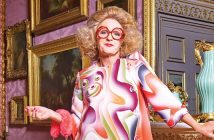The National Gallery’s latest exhibition shines the spotlight on a lesser-known hero of the Impressionist movement – the art dealer Paul Durand-Ruel.
Claude Monet, Camille Pisarro, Pierre-Auguste Renoir, Paul Durand-Ruel…it’s easy to spot the odd one out. Yet without Monsieur Durand-Ruel we may never have heard of the aforementioned artists. He was the Charles Saatchi of late 19th-century Paris, an early champion of Impressionist painters whose works had been shunned by the art establishment of the day and derided by the press.
Now Durand-Real is the focus of the National Gallery’s current blockbuster (which it certainly is judging by the jostling crowds when I visited on a Monday morning), the first time a UK show has been dedicated to him. It’s a fresh angle from which to appreciate Impressionist painting, or, rather more cynically, an excuse for the gallery to exhibit these crowd-pulling paintings anew – a sure-fire hit in the same vein as those compilation CDs of number ones, as few art historical subjects pull in the gallery crowds quite like Impressionism (largely thanks to Durand-Ruel).
Art dealing was the family business and when Durand-Real took over from his father in 1865 he was already a passionate fan of Delacroix, Corot and the Barbizon painters. Given the latter’s propensity for quick oil sketches made en plein air, an appreciation for the Impressionists’ style was perhaps a natural segue. Inspired by methods from the world of finance, he was soon buying the work of Manet, Monet and Pisarro in bulk (in one case sweeping up 23 Manet canvases on studio visit for 35,000 francs), securing exclusivity deals and mounting solo retrospectives, which until then had been reserved solely for post-humus establishment artists.
The show gets off to a fascinating start with a stage set of the dealer’s Parisian apartment as it would have been in the 1870s, Impressionist canvases displayed among the chandeliers and Louis XIV chairs. He would invite prospective buyers there to view how good this ‘new art’ looked in the setting of a bourgeois family apartment – a smart marketing tactic back when the public thought it not only ugly but even morally reprehensible.
If only there could have been more of this through the rest of the exhibition. But while it gives us the chronology and facts, I’m left wanting to know more about his relationships with the individual artists, whether he influenced (or tried to influence) their aesthetic or purely played the role of supporter, more about how he packaged and theorised on these controversial artworks. Where are the advertisements he reportedly placed, the letters selling in to clients or encouraging his artists? A case in point: the final room tells us the ‘triumphant’ Impressionism exhibition of 1905 was a game-changer in exhibition display, “an early example of curation.” But there’s no explanation about what his curatorial approach actually was, only four small photographs of the original hang in the opposite corner. More ambitious and directional staging could have brought this to life; how about replicating the 1905 display in this room, something a bit more immersive and audio-visual, as the V&A do so well?
The art, of course, doesn’t fail to dazzle: here are Degas’ ballet dancers, Renoir’s dappled nudes, a study for Manet’s final masterpiece A Bar at the Folies-Bergere. As the movement evolves before our eyes through the exhibition’s seven rooms – the brushwork loosening and fragmenting, impasto thickening, and compositions cropped in ever more dramatic ways – we learn that Durand-Ruel continued to back his artists, both financially (paying them a monthly salary) and emotionally, even when blighted by two banking crashes.
It also highlights the important role London played. While the opera halls, parks and boulevards of Paris form the classic Impressionist backdrops, it was to the British capital that Durand-Real retreated at the onset of the Prussian war and encountered two artists who would go on to be among his biggest success stories: Monet and Pisarro. And that seminal 1905 exhibition happened to be at the Grafton Galleries in Mayfair, too.
In the end, rather fittingly, it was in the New World that this new painting found a welcome home. Durand-Real established a gallery in New York and soon had American collectors clamouring. Before too long, the world followed. The captions of five canvases from Monet’s Poplars series neatly illuminate this global legacy: one is on loan from Philadelphia, two from Tokyo, one from the Tate and another at home in the d’Orsay.
Art and commerce have always been uneasy bedfellows, but this exhibition leaves you wondering just how different 20th-century art could have been if it weren’t for Durand-Ruel’s deep pockets and business savvy.
Inventing Impressionism is at the National Gallery, London until May 31st. For more information, visit the website.




